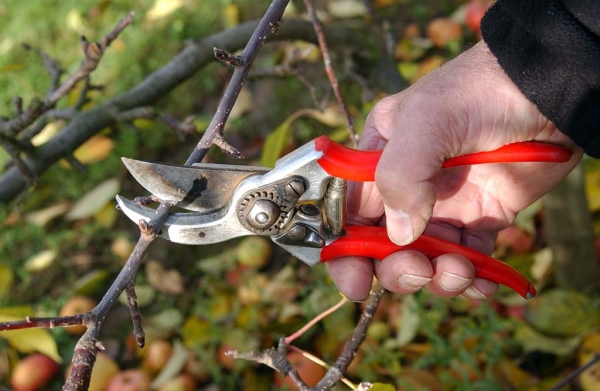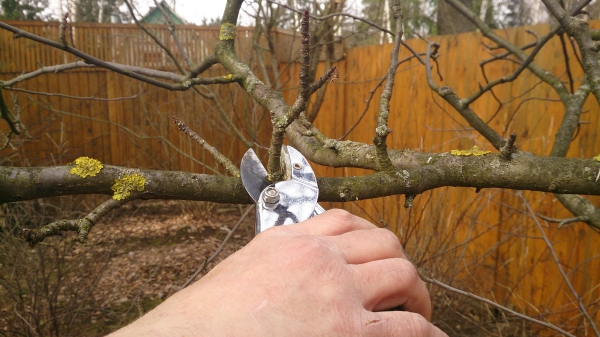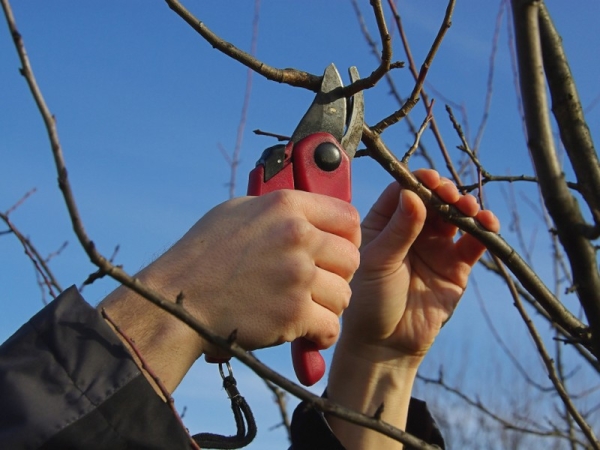There is no person who does not know the taste of pear. These juicy and sweet fruits will not leave anyone indifferent. And what compotes and jams are obtained from them!
Nowadays pear can be found on almost any garden area.
This tree, like any plant in the garden, requires some care. So that year after year it gives a good harvest, you need not only watering and fertilizer, but also competent pruning.
Table of contents
Proper formation of the crown of young pears with pruning
Since pear belongs to the light-loving culture, it is necessary to monitor the density of its crown.
What gives the correct pruning pear:
- abundant regular fruiting;
- further development of culture;
- creating a strong skeleton;
- convenience at harvest;
- good access when spraying.
If pruning is irregular or wrong, then the crown will be compacted, as the tree will begin to give all their strength to the growth of young shoots. This will lead to lower yields and a decrease in fruit size.
Another advantage of timely pruning: pear tree is quite high, and pruning branches will stop its growth. Due to this, other garden trees and shrubs will get more sunlight.
Crop pear instruction for beginners:
When is it better to prune shoots and tree branches
You can cut the pear in spring, and in summer, and in autumn, and even in winter. Pruning at a certain time of the year pursues its goals.
Summer care
Summer is done absolutely necessary. It happens that in spring, when pruning, we looked at several branches, and they began to grow rapidly, capturing the fruits that had already appeared on other, pruned, branches. In this case, summer pruning is possible.
Also at this time held pinching young shoots. It is much easier to remove them now, until they are numb, in addition, thanks to this circumcision, there is a transformation of leaf buds into fruit.

Is it possible to prune branches in winter?
Winter trim has some advantage. It lies in the fact that at this time of the year, when it is cold outside, all the plants, including the pear tree, are in “sleep mode”.
Therefore, it is much easier to tolerate wounds inflicted, healing is faster, and in the absence of juice the wood becomes more pliable.
Spring trimming scheme
Spring pruning of pears is considered the most important for the plant.She gives a guarantee of a good harvest. In the spring, as is known, the birth of the kidneys. This requires sunlight.
If in some place the crown is thickened, then there will be a blackout, respectively, there will not be flower buds there, which means there will be no fruits.
To avoid this, pruning should start with one year old saplingwhen its height reaches 50-60 cm.
You need to cut the tip about a quarter of the length, which will stimulate the lower branches to grow and form the correct crown. The branches in the neighborhood are cut "on the ring."

Trimming "on the ring" is done clearly in a kind of influxlocated at the very base of the branch. If you leave a big knot, it will lead to decay, and if you remove the branch flush, the wound will heal for a very long time.
The branches that form the basis of the trunk should be left, there should not be more than four.
As the tree matures, there are fewer shoots on it.To remedy this situation and increase the number of young sprouts on an aging tree, it is necessary to regularly trim the crown, rejuvenate it.
Spring pear pruning is recommended to begin. after the establishment of warm weather, in the absence of night frosts and solid plus at the daytime temperature.
But it is also impossible to be late with this, it is important to have time to prune before the circulation of tree sap has begun.
After spring pruning Nitrogen fertilizers should not be applied under the pear.. This may adversely affect the taste of the fruit. After hibernation, the tree itself actively pulls all the useful substances out of the ground.
Pear pruning:
How can and should be cut pear in autumn, rejuvenate it
Need to treat autumn pruning with great care. Ahead of winter, if you remove too many branches, the tree will be difficult to survive in the coming frosts.
The fact is that in September (namely, this time is the best for autumn pruning) woody sap continues to circulate, although it becomes slower.
The tree will start to spend the substances stored for the winter period in order to “heal” the wounds left after pruning.
Scheme correct autumn pruning pears:
- First, remove the dry and diseased branches, so that in the winter when they fall, they do not cripple the healthy branches.
- Find the branches that grow at a right angle to the trunk and also remove.
- Remove the branches that hinder the development of fruits. The remaining branches, which seem redundant, should only be shortened to remove them next year.
- Do not leave large knots, and cut "on the ring" (see above).
You may be interested in other publications:
A young pear should be pruned every autumn.or even twice a year, starting from the second year after planting. The reason: slow growth and poor tolerance of a cold winter.
Mature early-growing trees ripening may be cut from the second half of August to September 15-20. The procedure is the same:
- removal of damaged branches;
- thinning thickened crown;
- removal of branches affected by the disease;
- shortening shoots no older than one year.

At a later date, shortening is not recommended, since the possibility of shortening of shortened branches increases, which will lead to a decrease in yield.
Autumn pear pruning is the most effective way. return a good harvest from an aging tree. This pruning can be called rejuvenating.
In addition, if earlier it was not necessary to form the correct crown, then this pruning will allow thinning, which will lead to the emergence of young fruitful shoots.
If pear is over 18 years old, it is recommended to cut it once every five years.
How to form the crown of the columnar pear
Not so long ago, Russian gardens began to appear. columnar pear, already managed to conquer the hearts of our gardeners. From its tall "sisters", it is distinguished by its unpretentious care.
The main advantages of the columnar pear:
- always gives a rich harvest;
- more trees can be planted on the same plot;
- takes root well;
- gives large fruits;
- resistant to various sores;
- frost hardy
In the first year after landing pears should not be allowed to bloom, so that the seedling gains strength for further growth.
Next year need make so that in one inflorescence there is a maximum of two flowers to prevent the young tree from being overloaded with fruits.
Advice to novice gardeners: before pruning you need to pay attention to the apical bud. If she is healthy, then the tree has a central conductor.
If this bud is damaged, then other shoots appear. Of these, you should leave the strongest, remove the rest.

Often it is not necessary to cut the columnar pearin order to prevent the increased formation of branches. A young tree shoots should not be cut, and shorten, not forgetting to leave a pair of buds.
This should be done closer to the fall.. Most importantly, remove all side shoots that grow to the side. The central conductor can be cut only in one case: if its development is not enough. Then two or three buds should be left.
Despite the fact that pear requires constant care and delivers a lot of trouble with pruning, she gives all of herself without the balance with her divine fruits, giving the gardener the joy and enjoyment of the results of his work.
